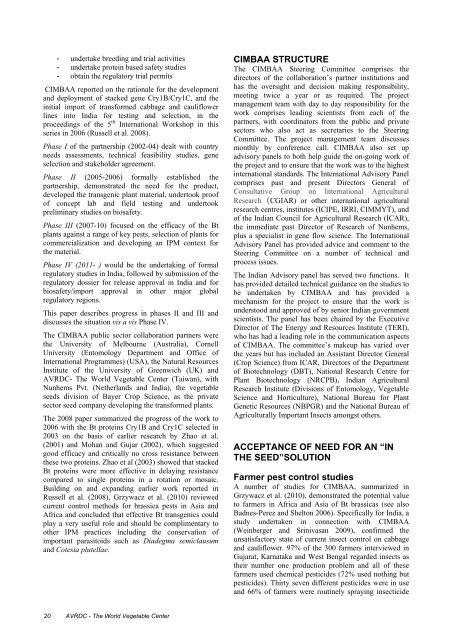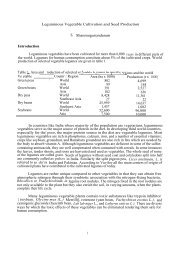Management of the Diamondback Moth and Other Crucifer Insect ...
Management of the Diamondback Moth and Other Crucifer Insect ...
Management of the Diamondback Moth and Other Crucifer Insect ...
You also want an ePaper? Increase the reach of your titles
YUMPU automatically turns print PDFs into web optimized ePapers that Google loves.
- undertake breeding <strong>and</strong> trial activities- undertake protein based safety studies- obtain <strong>the</strong> regulatory trial permitsCIMBAA reported on <strong>the</strong> rationale for <strong>the</strong> development<strong>and</strong> deployment <strong>of</strong> stacked gene Cry1B/Cry1C, <strong>and</strong> <strong>the</strong>initial import <strong>of</strong> transformed cabbage <strong>and</strong> cauliflowerlines into India for testing <strong>and</strong> selection, in <strong>the</strong>proceedings <strong>of</strong> <strong>the</strong> 5 th International Workshop in thisseries in 2006 (Russell et al. 2008).Phase I <strong>of</strong> <strong>the</strong> partnership (2002-04) dealt with countryneeds assessments, technical feasibility studies, geneselection <strong>and</strong> stakeholder agreement.Phase II (2005-2006) formally established <strong>the</strong>partnership, demonstrated <strong>the</strong> need for <strong>the</strong> product,developed <strong>the</strong> transgenic plant material, undertook pro<strong>of</strong><strong>of</strong> concept lab <strong>and</strong> field testing <strong>and</strong> undertookpreliminary studies on biosafety.Phase III (2007-10) focused on <strong>the</strong> efficacy <strong>of</strong> <strong>the</strong> Btplants against a range <strong>of</strong> key pests, selection <strong>of</strong> plants forcommercialization <strong>and</strong> developing an IPM context for<strong>the</strong> material.Phase IV (2011- ) would be <strong>the</strong> undertaking <strong>of</strong> formalregulatory studies in India, followed by submission <strong>of</strong> <strong>the</strong>regulatory dossier for release approval in India <strong>and</strong> forbiosafety/import approval in o<strong>the</strong>r major globalregulatory regions.This paper describes progress in phases II <strong>and</strong> III <strong>and</strong>discusses <strong>the</strong> situation vis a vis Phase IV.The CIMBAA public sector collaboration partners were<strong>the</strong> University <strong>of</strong> Melbourne (Australia), CornellUniversity (Entomology Department <strong>and</strong> Office <strong>of</strong>International Programmes) (USA), <strong>the</strong> Natural ResourcesInstitute <strong>of</strong> <strong>the</strong> University <strong>of</strong> Greenwich (UK) <strong>and</strong>AVRDC- The World Vegetable Center (Taiwan), withNunhems Pvt. (Ne<strong>the</strong>rl<strong>and</strong>s <strong>and</strong> India), <strong>the</strong> vegetableseeds division <strong>of</strong> Bayer Crop Science, as <strong>the</strong> privatesector seed company developing <strong>the</strong> transformed plants.The 2008 paper summarized <strong>the</strong> progress <strong>of</strong> <strong>the</strong> work to2006 with <strong>the</strong> Bt proteins Cry1B <strong>and</strong> Cry1C selected in2003 on <strong>the</strong> basis <strong>of</strong> earlier research by Zhao et al.(2001) <strong>and</strong> Mohan <strong>and</strong> Gujar (2002), which suggestedgood efficacy <strong>and</strong> critically no cross resistance between<strong>the</strong>se two proteins. Zhao et al (2003) showed that stackedBt proteins were more effective in delaying resistancecompared to single proteins in a rotation or mosaic.Building on <strong>and</strong> exp<strong>and</strong>ing earlier work reported inRussell et al. (2008), Grzywacz et al. (2010) reviewedcurrent control methods for brassica pests in Asia <strong>and</strong>Africa <strong>and</strong> concluded that effective Bt transgenics couldplay a very useful role <strong>and</strong> should be complimentary too<strong>the</strong>r IPM practices including <strong>the</strong> conservation <strong>of</strong>important parasitoids such as Diadegma semiclausum<strong>and</strong> Cotesia plutellae.CIMBAA STRUCTUREThe CIMBAA Steering Committee comprises <strong>the</strong>directors <strong>of</strong> <strong>the</strong> collaboration’s partner institutions <strong>and</strong>has <strong>the</strong> oversight <strong>and</strong> decision making responsibility,meeting twice a year or as required. The projectmanagement team with day to day responsibility for <strong>the</strong>work comprises leading scientists from each <strong>of</strong> <strong>the</strong>partners, with coordinators from <strong>the</strong> public <strong>and</strong> privatesectors who also act as secretaries to <strong>the</strong> SteeringCommittee. The project management team discussesmonthly by conference call. CIMBAA also set upadvisory panels to both help guide <strong>the</strong> on-going work <strong>of</strong><strong>the</strong> project <strong>and</strong> to ensure that <strong>the</strong> work was to <strong>the</strong> highestinternational st<strong>and</strong>ards. The International Advisory Panelcomprises past <strong>and</strong> present Directors General <strong>of</strong>Consultative Group on International AgriculturalResearch (CGIAR) or o<strong>the</strong>r international agriculturalresearch centres, institutes (ICIPE, IRRI, CIMMYT), <strong>and</strong><strong>of</strong> <strong>the</strong> Indian Council for Agricultural Research (ICAR),<strong>the</strong> immediate past Director <strong>of</strong> Research <strong>of</strong> Nunhems,plus a specialist in gene flow science. The InternationalAdvisory Panel has provided advice <strong>and</strong> comment to <strong>the</strong>Steering Committee on a number <strong>of</strong> technical <strong>and</strong>process issues.The Indian Advisory panel has served two functions. Ithas provided detailed technical guidance on <strong>the</strong> studies tobe undertaken by CIMBAA <strong>and</strong> has provided amechanism for <strong>the</strong> project to ensure that <strong>the</strong> work isunderstood <strong>and</strong> approved <strong>of</strong> by senior Indian governmentscientists. The panel has been chaired by <strong>the</strong> ExecutiveDirector <strong>of</strong> The Energy <strong>and</strong> Resources Institute (TERI),who has had a leading role in <strong>the</strong> communication aspects<strong>of</strong> CIMBAA. The committee’s makeup has varied over<strong>the</strong> years but has included an Assistant Director General(Crop Science) from ICAR, Directors <strong>of</strong> <strong>the</strong> Department<strong>of</strong> Biotechnology (DBT), National Research Centre forPlant Biotechnology (NRCPB), Indian AgriculturalResearch Institute (Divisions <strong>of</strong> Entomology, VegetableScience <strong>and</strong> Horticulture), National Bureau for PlantGenetic Resources (NBPGR) <strong>and</strong> <strong>the</strong> National Bureau <strong>of</strong>Agriculturally Important <strong>Insect</strong>s amongst o<strong>the</strong>rs.ACCEPTANCE OF NEED FOR AN “INTHE SEED”SOLUTIONFarmer pest control studiesA number <strong>of</strong> studies for CIMBAA, summarized inGrzywacz et al. (2010), demonstrated <strong>the</strong> potential valueto farmers in Africa <strong>and</strong> Asia <strong>of</strong> Bt brassicas (see alsoBadnes-Perez <strong>and</strong> Shelton 2006). Specifically for India, astudy undertaken in connection with CIMBAA(Weinberger <strong>and</strong> Srinivasan 2009), confirmed <strong>the</strong>unsatisfactory state <strong>of</strong> current insect control on cabbage<strong>and</strong> cauliflower. 97% <strong>of</strong> <strong>the</strong> 300 farmers interviewed inGujarat, Karnataka <strong>and</strong> West Bengal regarded insects as<strong>the</strong>ir number one production problem <strong>and</strong> all <strong>of</strong> <strong>the</strong>sefarmers used chemical pesticides (72% used nothing butpesticides). Thirty seven different pesticides were in use<strong>and</strong> 66% <strong>of</strong> farmers were routinely spraying insecticide20 AVRDC - The World Vegetable Center
















